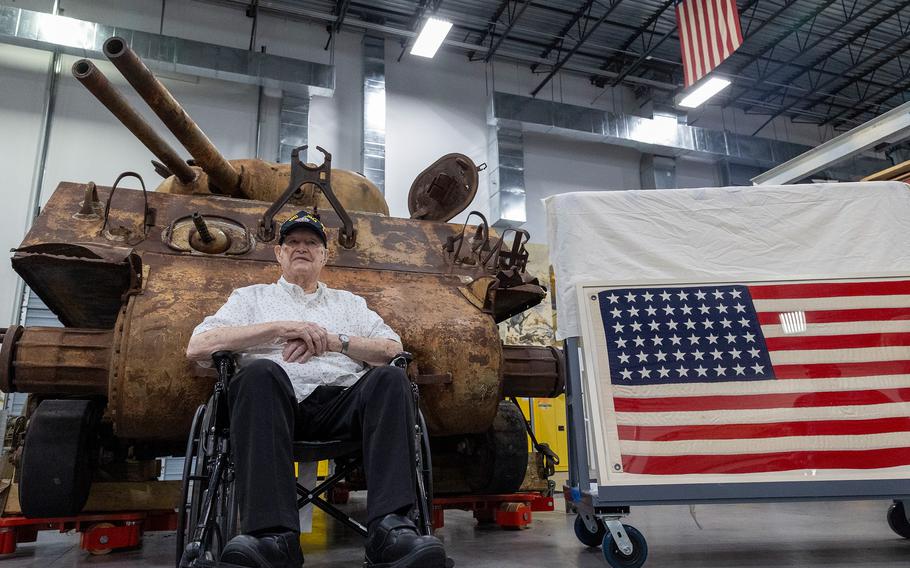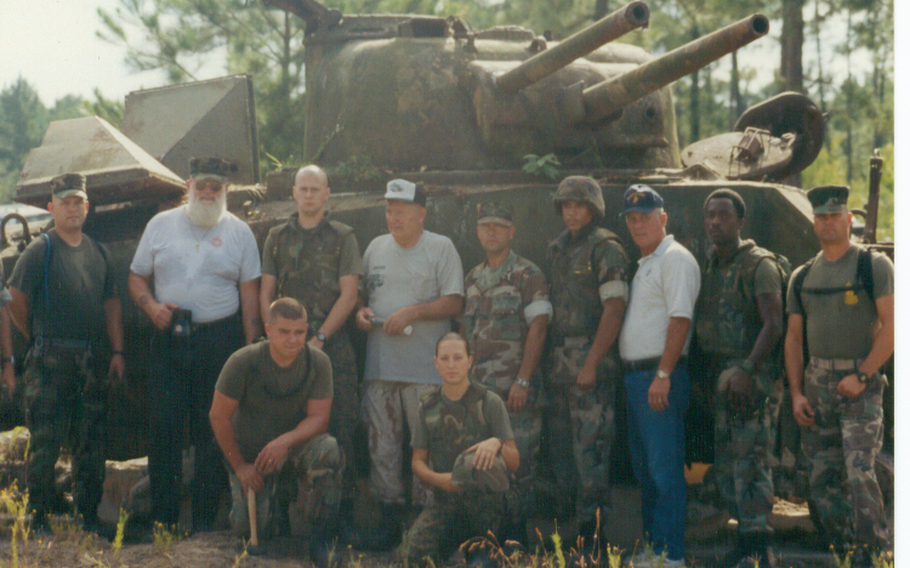
World War II Marine veteran Cpl. Leighton Willhite, 100, sits in front of the M4A3 Sherman tank he drove during the Battle of Iwo Jima in 1945, in Dumfries, Va., Friday, Aug. 15, 2025. (Eric Kayne/Stars and Stripes)
DUMFRIES, Va. — A 100 year-old World War II veteran and Marine tank driver reunited with the tank that once carried him through the Battle of Iwo Jima, rekindling his memory of one of the fiercest fights in Marine Corps history.
Marine Cpl. Leighton Willhite sat in front of the M4A3 Sherman tank, nicknamed “Lucky,” for the first time in 80 years at the National Museum of the Marine Corps’ support facility in Dumfries on Friday, the anniversary of Japan’s surrender in WWII.
“It’s amazing,” Willhite said. “I never thought I would see the tank again. That tank was my life.” He added that if the tank was in good shape, he would fire it up again.
Willhite was accompanied by his son, grandson and great grandson at the reunion.
“I’m glad this happened while he’s still living,” said Chad, Willhite’s son. “It means everything to him, which is what it means to me. Everybody that has been around him tells his [Willhite’s] story.”
At 19, Willhite drove Lucky — one of only six confirmed Iwo Jima Sherman tanks in existence today — ashore the black sands of Red Beach II on Iwo Jima with the 5th Tank Battalion in 1945.
“I probably wasn’t the best driver in the world, but I wasn’t the worst,” Willhite said.
As Willhite touched and observed the tank, he reminisced on his days where he and his crew supported infantry units and took part in life-saving rescue efforts. During the battle, Willhite earned the Bronze Star with valor after assisting in the rescue of another Marine tank crew, “Jeannie,” under fire at Hill 362A, north of Mount Suribachi.
“My service was probably short, but I gave it all I had,” Willhite said.
Jonathan Bernstein, arms and armor curator at the NMMC, saw the tank for the first time in 2023 and spent two years conducting extensive historical research and archaeological work on the tank. He was finally able to identify Lucky, trace back its service on Iwo Jima and connect the tank to Willhite.
“I was really lucky with how everything came together,” Bernstein said, adding that he was “borderline obsessive” with identifying the tank. “This is the end of the beginning. As we move forward, this is going to get a lot more exciting as Lucky gets back to what she looked like on Iwo Jima.”
The NMMC plans to restore Lucky within the next five years and eventually put it on display at the museum.
“I hope that folks that serve in the Marine Corps are differently inspired by this,” said Keil Gentry, director at the NMMC. “Those who have not served in the Marine Corps, I think this is a great way to talk about the veteran service and sacrifice”

Master Gunnery Sgt. Lisa Marshall’s platoon recovers the M4A3 Sherman tank, “Lucky,” at Marine Corps Base Camp Lejeune, N.C., in 2001. (National Museum of the Marine Corps)
After the Battle of Iwo Jima ended on March 26, 1945, the 5th Marine Division returned to Hawaii, and the 5th Tank Battalion turned in their tanks for refitting and training for the invasion of Japan.
In the 1970s, Lucky made its way to Marine Corps Base Camp Lejeune, N.C., where an attempt was made to preserve her. But due to a lack of funding, the tank was moved into the woods of 2nd Tank Battalion’s training areas and remained undiscovered until Master Gunnery Sgt. Lisa Marshall and her platoon found and recovered Lucky, then shipped her to the NMMC in 2001.
Marshall, who attended the reunion, said she was only following orders at the time and never would have thought she would witness the special reunion of Willhite and Lucky.
“I had a very physical, emotional reaction to knowing that I was able to be a part of … being able to give a memory back to somebody,” Marshall said.